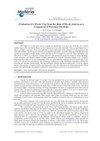地聚合物轻质混凝土力学性能试验研究
IF 1.2
4区 材料科学
Q4 MATERIALS SCIENCE, MULTIDISCIPLINARY
引用次数: 0
摘要
开发轻质地聚合物混凝土是本研究工作的主要目标,并将研究成果与对照配合比进行了评价。本研究以粉煤灰为粘结剂,合成砂为m砂为细骨料,椰壳灰和棕榈壳灰为粗骨料制备地聚合物混凝土。为了通过试验配合比的选择,进行了初步的研究。粘结剂的数量、粗细骨料、氢氧化钠的摩尔浓度、水玻璃与氢氧化钠的比、碱性粘结剂的比是目前研究中考虑的重要变量。探讨各种因素对地聚合物混凝土工程特性的影响。利用试验配合比为1:2.36:1.02、摩尔浓度为16、粘结料比为0.6的地聚合物混凝土的性能进行了评价,主要发现椰子壳废料和棕榈壳可以代替细骨料。对地聚合物混凝土的力学性能进行了深入的研究,包括控制配合比对其力学性能和耐久性的影响。本文章由计算机程序翻译,如有差异,请以英文原文为准。
Experimental investigation on mechanical behavior of geopolymer light weight concrete
The development of lightweight geopolymer concrete is the main goal of this research work, and the outcomes were evaluated in comparison to the control mix. In this work, geopolymer concrete was produced using fly ash as a binder, synthetic sand as M-sand as fine aggregate, and coconut shell as well as palm shell ash for coarse aggregate. For the purpose of selecting a mix proportion via trial mixes, an initial investigation was conducted. The quantity among binder, fine and coarse aggregate, sodium hydroxide molarity, sodium silicate: sodium hydroxide ratio, the alkaline binder ratio is some of the significant variables taken into account in the current study. Investigation of the effects of various factors on the engineering characteristics of geopolymer concrete. The trial mixes were utilized to evaluate the characteristics for geopolymer concrete with a ratio of 1: 2.36 :1.02 and a Molarity of 16 with binder ratio 0.6 The key findings of this investigation is to that the coconut shell waste and palm shell can be replaced instead of fine aggregate. In-depth research was done on the mechanical behavior with geopolymer concrete, such as the mechanical and durability characteristics with control mix.
求助全文
通过发布文献求助,成功后即可免费获取论文全文。
去求助
来源期刊

Materia-rio De Janeiro
MATERIALS SCIENCE, MULTIDISCIPLINARY-
CiteScore
1.00
自引率
25.00%
发文量
51
审稿时长
6 weeks
期刊介绍:
All the articles are submitted to a careful peer-reviewing evaluation process by the journal''s Editorial Board. The Editorial Board, reviewers and authors make use of a web based proprietary automated tool to deal with the reviewing procedures.the Revista Matéria''s article reviewing restricted access system - SEER. Authors are not informed about the identity of the reviewers.
 求助内容:
求助内容: 应助结果提醒方式:
应助结果提醒方式:


